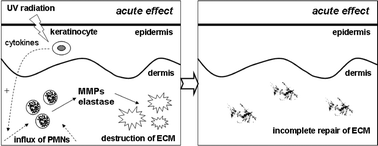UV-induced skin damage is the result of a complex cascade of events. Many studies have focused on the skin effects induced by UV-B or UV-A separately. Recently a UV-source that emits UV-B and UV-A together in a ratio comparable to daily sunlight has been introduced: i.e. solar simulated radiation (SSR). By exposing human skin type I–III to erythematogenic doses of UV (≥1 MED) emitted by a SSR source we have noticed that: (a) neutrophils are initially the main infiltrating cell type in the dermis and (b) these infiltrating cells are the a key source of in vivo enzymatic active enzymes such as elastase and matrix metallo proteinases-1 and -9 (MMPs-1 and -9). These enzymes are relevant to the process of photoaging, as they break down the extracellular matrix. Keratinocytes and fibroblasts also produce matrix degrading enzymes, but to a lesser extent. Our results indicate a primary role for infiltrating neutrophils in the initial steps of photoaging. This is further supported by the observation that after exposure of skin type VI to physical doses of SSR, equivalent to those used for skin types I–III, no neutrophils and neutrophil-derived enzymatic activity were observed, explaining why skin type VI shows less macroscopic signs of photoaging than skin type I–III. Statement: Although most of the data, referred to, have been published, the current perspective in which they are put together is completely novel and has not been published elsewhere.

You have access to this article
 Please wait while we load your content...
Something went wrong. Try again?
Please wait while we load your content...
Something went wrong. Try again?


 Please wait while we load your content...
Please wait while we load your content...